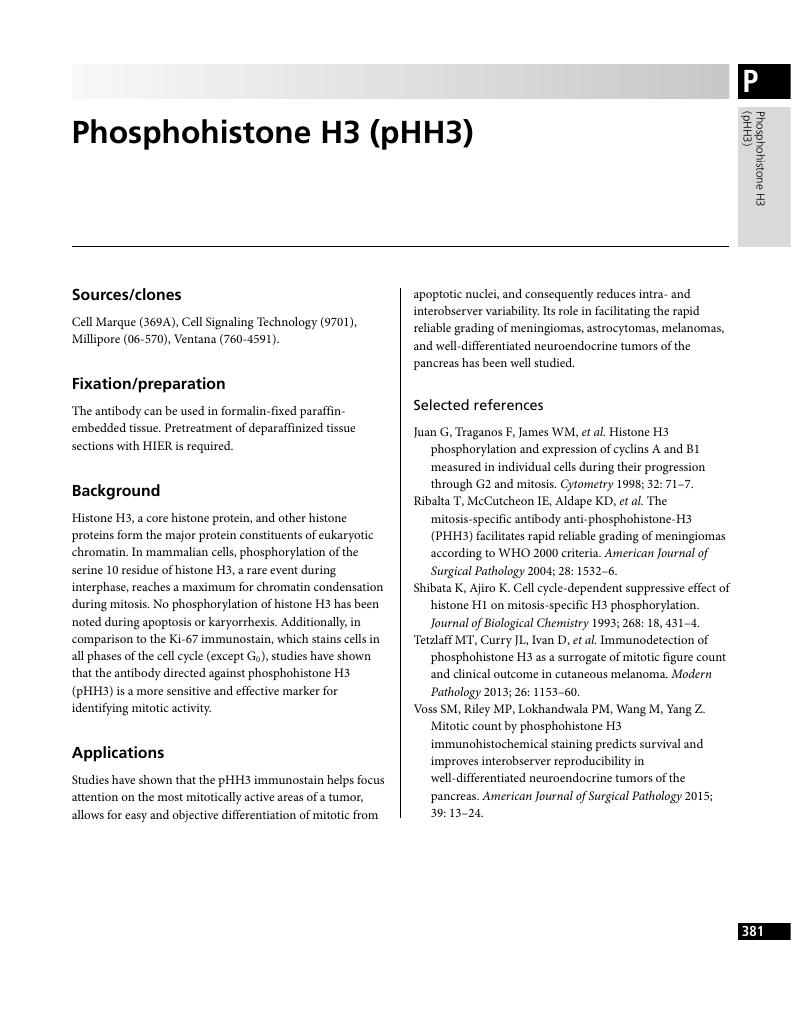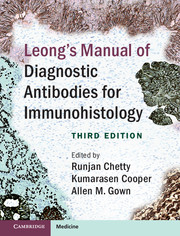Book contents
- Leong's Manual of Diagnostic Antibodies for ImmunohistologyThird Edition
- Leong's Manual of Diagnostic Antibodies for Immunohistology
- Copyright page
- Dedication
- Contents
- Contributors
- Preface to the first edition
- Preface to the second edition
- Preface to the third edition
- Note
- Introduction
- Section 1 Antibodies
- α-Fetoprotein (AFP)
- α-Smooth muscle actin (α-SMA)
- AMACR
- Amyloid
- Anaplastic lymphoma kinase (ALK)
- Androgen receptor
- Anti-apoptosis
- Arginase-1
- Bcl-2
- Bcl-6
- Ber-EP4
- β-hCG (human chorionic gonadotropin)
- BOB-1
- Brachyury
- CA125
- N/97-Cadherin/E-Cadherin
- CAIX
- Calcitonin
- h-Caldesmon
- Calponin
- Calreticulin
- Calretinin
- Candida albicans
- Carcinoembryonic antigen (CEA)
- Catenins α, β, γ
- CD1
- CD2
- CD3
- CD4
- CD5
- CD7
- CD8
- CD9
- CD10 (CALLA)
- CD11
- CD15
- CD19
- CD20
- CD21
- CD23
- CD24
- CD25
- CD30 (Ki-1)
- CD31
- CD33
- CD34
- CD35
- CD38
- CD40
- CD43
- CD44
- CD45 (leukocyte common antigen)
- CD54 (ICAM-1)
- CD56 (neural cell adhesion molecule)
- CD57
- CD68
- CD71
- CD74 (LN-2)
- CDw75 (LN-1)
- CD79a
- CD99 (p30/32MIC2)
- CD103
- CD117 (KIT)
- CD123
- CD138
- CD163
- CDK4
- CDX2 (caudal type homeobox 2)
- c-erbB-2 (HER2, neu)
- Chlamydia
- Chromogranin
- c-Myc
- Collagen type IV
- CXCL13
- Cyclin D1 (Bcl-1)
- Cytokeratins
- Cytokeratin 5/6 (CK5/6)
- Cytokeratin 7 (CK7)
- Cytokeratin 19 (CK19)
- Cytokeratin 20 (CK20)
- Cytokeratins: AE1/AE3
- Cytokeratins: 34βE12
- Cytokeratins: CAM 5.2
- Cytokeratins: MAK-6
- Cytokeratins: MNF116
- Other pan-cytokeratin cocktails
- Cytomegalovirus (CMV)
- Cytotoxic molecules (TIA-1, granzyme B, perforin)
- D2-40
- DBA.44 (hairy cell leukemia)
- Desmin
- Desmoplakins
- DOG1
- DPC4/SMAD4
- EMA (epithelial membrane antigen)
- Epidermal growth factors: EGFR
- Epidermal growth factors: TGF-α
- Epstein–Barr virus, LMP
- ERG
- Erythropoietin
- Factor VIII RA (von Willebrand factor)
- Factor XIIIa
- Fas (CD95) and Fas-ligand (CD95L)
- Fascin
- Ferritin
- Fibrin
- Fibrinogen
- Fibronectin
- Fli-1
- FMC-7
- Forkhead box L2 (FOXL2)
- GATA binding protein 3 (GATA3)
- Glial fibrillary acidic protein (GFAP)
- Glut-1
- Glypican-3
- Gross cystic disease fluid protein 15 (GCDFP-15, BRST-2)
- HBME-1 (mesothelial cell)
- Helicobacter pylori
- Hep Par 1 (hepatocyte marker)
- Hepatitis B core antigen (HBcAg)
- Hepatitis B surface antigen (HBsAg)
- Herpes simplex virus I and II (HSV I and II)
- HHV-8 LANA-1
- HLA-DR
- HMB-45 (melanoma marker)
- hMLH1 and hMSH2 (mismatch repair proteins)
- Human immunodeficiency virus (HIV)
- Human papillomavirus (HPV)
- Human parvovirus B19
- Human placental lactogen (hPL)
- Immunoglobulins: Igκ, Igλ, IgA, IgD, IgE, IgG, IgM
- IgG4
- Inhibin
- Islet1
- Ki-67 (MIB1, Ki-S5)
- Laminin
- Mammaglobin
- MART-1/Melan-A
- MDM-2 protein
- Measles
- Mel-CAM (CD146)
- Mesothelin
- Metallothioneins
- Microphthalmia transcription factor (MiTF)
- Mitochondria
- MOC-31
- MSA (muscle-specific actin)
- MUM1
- Mutated BRAF V600E
- Mutated IDH-1 (mIDH1-R132H, R132S, R132G)
- Mycobacterial antigen
- Myeloperoxidase
- MyoD1
- Myogenin
- Myoglobin
- Napsin-A
- Neurofilaments
- Neutrophil elastase
- nm23/NME1
- NUT
- OCT2
- OCT4
- OLIG2 (oligodendrocyte transcription factor 2)
- Osteopontin
- p16
- p27kip1
- p40
- p53
- p63
- Pancreatic hormones: insulin, somatostatin, vasoactive intestinal polypeptide, gastrin, glucagon, pancreatic polypeptide
- Parafibromin (CDC73)
- Parathyroid hormone
- Parathyroid hormone-related protein (PTHrP)
- PAX-2 (paired box gene 2)
- PAX-5
- PAX-8
- PD-1
- P-glycoprotein (P-170), multidrug resistance (MDR)
- Phosphohistone H3 (pHH3)
- PIT1 (POU1F1)
- Pituitary hormones: ACTH, FSH, hGH, LH, PRL, TSH
- PLAP (placental alkaline phosphatase)
- PMS2
- Pneumocystis jirovecii
- Pregnancy-specific β-1-glycoprotein (SP1)
- Progesterone receptor (PR)
- Protein gene product 9.5 (PGP 9.5)
- Proto-oncogene tyrosine-protein kinase 1 (ROS1)
- pS2
- PSA (prostate-specific antigen)
- PSAP (prostate-specific acid phosphatase)
- PTEN (phosphatase and tensin homolog deleted on chromosome 10)
- Rabies
- Retinoblastoma gene protein (P110RB, Rb protein)
- S100
- SALL4
- SDHB (succinate dehydrogenase complex, subunit B)
- Serotonin
- Simian virus 40 (SV40 T antigen)
- SMARCB1
- Smooth muscle myosin heavy chain
- SOX9
- SOX10
- Spectrin/fodrin
- Surfactant apoprotein A
- Synaptophysin
- Tau
- T-cell receptor
- Tenascin
- Terminal deoxynucleotidyl transferase (TdT)
- TFE3
- Thrombomodulin
- Thyroglobulin
- TLE1
- Topoisomerase llα
- Transthyretin (prealbumin, TTR)
- Tyrosinase
- Tyrosine hydroxylase
- Ubiquitin
- Ulex europaeus agglutinin 1 lectin (UEA-1)
- VEGF (vascular endothelial growth factor)
- Villin
- Vimentin
- VS38
- WT1
- Book part
- References
Phosphohistone H3 (pHH3)
from Section 1 - Antibodies
Published online by Cambridge University Press: 27 October 2016
- Leong's Manual of Diagnostic Antibodies for ImmunohistologyThird Edition
- Leong's Manual of Diagnostic Antibodies for Immunohistology
- Copyright page
- Dedication
- Contents
- Contributors
- Preface to the first edition
- Preface to the second edition
- Preface to the third edition
- Note
- Introduction
- Section 1 Antibodies
- α-Fetoprotein (AFP)
- α-Smooth muscle actin (α-SMA)
- AMACR
- Amyloid
- Anaplastic lymphoma kinase (ALK)
- Androgen receptor
- Anti-apoptosis
- Arginase-1
- Bcl-2
- Bcl-6
- Ber-EP4
- β-hCG (human chorionic gonadotropin)
- BOB-1
- Brachyury
- CA125
- N/97-Cadherin/E-Cadherin
- CAIX
- Calcitonin
- h-Caldesmon
- Calponin
- Calreticulin
- Calretinin
- Candida albicans
- Carcinoembryonic antigen (CEA)
- Catenins α, β, γ
- CD1
- CD2
- CD3
- CD4
- CD5
- CD7
- CD8
- CD9
- CD10 (CALLA)
- CD11
- CD15
- CD19
- CD20
- CD21
- CD23
- CD24
- CD25
- CD30 (Ki-1)
- CD31
- CD33
- CD34
- CD35
- CD38
- CD40
- CD43
- CD44
- CD45 (leukocyte common antigen)
- CD54 (ICAM-1)
- CD56 (neural cell adhesion molecule)
- CD57
- CD68
- CD71
- CD74 (LN-2)
- CDw75 (LN-1)
- CD79a
- CD99 (p30/32MIC2)
- CD103
- CD117 (KIT)
- CD123
- CD138
- CD163
- CDK4
- CDX2 (caudal type homeobox 2)
- c-erbB-2 (HER2, neu)
- Chlamydia
- Chromogranin
- c-Myc
- Collagen type IV
- CXCL13
- Cyclin D1 (Bcl-1)
- Cytokeratins
- Cytokeratin 5/6 (CK5/6)
- Cytokeratin 7 (CK7)
- Cytokeratin 19 (CK19)
- Cytokeratin 20 (CK20)
- Cytokeratins: AE1/AE3
- Cytokeratins: 34βE12
- Cytokeratins: CAM 5.2
- Cytokeratins: MAK-6
- Cytokeratins: MNF116
- Other pan-cytokeratin cocktails
- Cytomegalovirus (CMV)
- Cytotoxic molecules (TIA-1, granzyme B, perforin)
- D2-40
- DBA.44 (hairy cell leukemia)
- Desmin
- Desmoplakins
- DOG1
- DPC4/SMAD4
- EMA (epithelial membrane antigen)
- Epidermal growth factors: EGFR
- Epidermal growth factors: TGF-α
- Epstein–Barr virus, LMP
- ERG
- Erythropoietin
- Factor VIII RA (von Willebrand factor)
- Factor XIIIa
- Fas (CD95) and Fas-ligand (CD95L)
- Fascin
- Ferritin
- Fibrin
- Fibrinogen
- Fibronectin
- Fli-1
- FMC-7
- Forkhead box L2 (FOXL2)
- GATA binding protein 3 (GATA3)
- Glial fibrillary acidic protein (GFAP)
- Glut-1
- Glypican-3
- Gross cystic disease fluid protein 15 (GCDFP-15, BRST-2)
- HBME-1 (mesothelial cell)
- Helicobacter pylori
- Hep Par 1 (hepatocyte marker)
- Hepatitis B core antigen (HBcAg)
- Hepatitis B surface antigen (HBsAg)
- Herpes simplex virus I and II (HSV I and II)
- HHV-8 LANA-1
- HLA-DR
- HMB-45 (melanoma marker)
- hMLH1 and hMSH2 (mismatch repair proteins)
- Human immunodeficiency virus (HIV)
- Human papillomavirus (HPV)
- Human parvovirus B19
- Human placental lactogen (hPL)
- Immunoglobulins: Igκ, Igλ, IgA, IgD, IgE, IgG, IgM
- IgG4
- Inhibin
- Islet1
- Ki-67 (MIB1, Ki-S5)
- Laminin
- Mammaglobin
- MART-1/Melan-A
- MDM-2 protein
- Measles
- Mel-CAM (CD146)
- Mesothelin
- Metallothioneins
- Microphthalmia transcription factor (MiTF)
- Mitochondria
- MOC-31
- MSA (muscle-specific actin)
- MUM1
- Mutated BRAF V600E
- Mutated IDH-1 (mIDH1-R132H, R132S, R132G)
- Mycobacterial antigen
- Myeloperoxidase
- MyoD1
- Myogenin
- Myoglobin
- Napsin-A
- Neurofilaments
- Neutrophil elastase
- nm23/NME1
- NUT
- OCT2
- OCT4
- OLIG2 (oligodendrocyte transcription factor 2)
- Osteopontin
- p16
- p27kip1
- p40
- p53
- p63
- Pancreatic hormones: insulin, somatostatin, vasoactive intestinal polypeptide, gastrin, glucagon, pancreatic polypeptide
- Parafibromin (CDC73)
- Parathyroid hormone
- Parathyroid hormone-related protein (PTHrP)
- PAX-2 (paired box gene 2)
- PAX-5
- PAX-8
- PD-1
- P-glycoprotein (P-170), multidrug resistance (MDR)
- Phosphohistone H3 (pHH3)
- PIT1 (POU1F1)
- Pituitary hormones: ACTH, FSH, hGH, LH, PRL, TSH
- PLAP (placental alkaline phosphatase)
- PMS2
- Pneumocystis jirovecii
- Pregnancy-specific β-1-glycoprotein (SP1)
- Progesterone receptor (PR)
- Protein gene product 9.5 (PGP 9.5)
- Proto-oncogene tyrosine-protein kinase 1 (ROS1)
- pS2
- PSA (prostate-specific antigen)
- PSAP (prostate-specific acid phosphatase)
- PTEN (phosphatase and tensin homolog deleted on chromosome 10)
- Rabies
- Retinoblastoma gene protein (P110RB, Rb protein)
- S100
- SALL4
- SDHB (succinate dehydrogenase complex, subunit B)
- Serotonin
- Simian virus 40 (SV40 T antigen)
- SMARCB1
- Smooth muscle myosin heavy chain
- SOX9
- SOX10
- Spectrin/fodrin
- Surfactant apoprotein A
- Synaptophysin
- Tau
- T-cell receptor
- Tenascin
- Terminal deoxynucleotidyl transferase (TdT)
- TFE3
- Thrombomodulin
- Thyroglobulin
- TLE1
- Topoisomerase llα
- Transthyretin (prealbumin, TTR)
- Tyrosinase
- Tyrosine hydroxylase
- Ubiquitin
- Ulex europaeus agglutinin 1 lectin (UEA-1)
- VEGF (vascular endothelial growth factor)
- Villin
- Vimentin
- VS38
- WT1
- Book part
- References
Summary

- Type
- Chapter
- Information
- Leong's Manual of Diagnostic Antibodies for Immunohistology , pp. 381 - 382Publisher: Cambridge University PressPrint publication year: 2016



